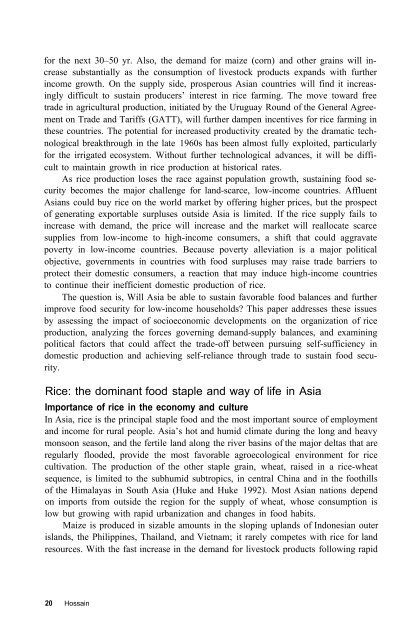Sustainability of rice in the global food system - IRRI books
Sustainability of rice in the global food system - IRRI books
Sustainability of rice in the global food system - IRRI books
Create successful ePaper yourself
Turn your PDF publications into a flip-book with our unique Google optimized e-Paper software.
for <strong>the</strong> next 30–50 yr. Also, <strong>the</strong> demand for maize (corn) and o<strong>the</strong>r gra<strong>in</strong>s will <strong>in</strong>crease<br />
substantially as <strong>the</strong> consumption <strong>of</strong> livestock products expands with fur<strong>the</strong>r<br />
<strong>in</strong>come growth. On <strong>the</strong> supply side, prosperous Asian countries will f<strong>in</strong>d it <strong>in</strong>creas<strong>in</strong>gly<br />
difficult to susta<strong>in</strong> producers’ <strong>in</strong>terest <strong>in</strong> <strong>rice</strong> farm<strong>in</strong>g. The move toward free<br />
trade <strong>in</strong> agricultural production, <strong>in</strong>itiated by <strong>the</strong> Uruguay Round <strong>of</strong> <strong>the</strong> General Agreement<br />
on Trade and Tariffs (GATT), will fur<strong>the</strong>r dampen <strong>in</strong>centives for <strong>rice</strong> farm<strong>in</strong>g <strong>in</strong><br />
<strong>the</strong>se countries. The potential for <strong>in</strong>creased productivity created by <strong>the</strong> dramatic technological<br />
breakthrough <strong>in</strong> <strong>the</strong> late 1960s has been almost fully exploited, particularly<br />
for <strong>the</strong> irrigated eco<strong>system</strong>. Without fur<strong>the</strong>r technological advances, it will be difficult<br />
to ma<strong>in</strong>ta<strong>in</strong> growth <strong>in</strong> <strong>rice</strong> production at historical rates.<br />
As <strong>rice</strong> production loses <strong>the</strong> race aga<strong>in</strong>st population growth, susta<strong>in</strong><strong>in</strong>g <strong>food</strong> security<br />
becomes <strong>the</strong> major challenge for land-scarce, low-<strong>in</strong>come countries. Affluent<br />
Asians could buy <strong>rice</strong> on <strong>the</strong> world market by <strong>of</strong>fer<strong>in</strong>g higher p<strong>rice</strong>s, but <strong>the</strong> prospect<br />
<strong>of</strong> generat<strong>in</strong>g exportable surpluses outside Asia is limited. If <strong>the</strong> <strong>rice</strong> supply fails to<br />
<strong>in</strong>crease with demand, <strong>the</strong> p<strong>rice</strong> will <strong>in</strong>crease and <strong>the</strong> market will reallocate scarce<br />
supplies from low-<strong>in</strong>come to high-<strong>in</strong>come consumers, a shift that could aggravate<br />
poverty <strong>in</strong> low-<strong>in</strong>come countries. Because poverty alleviation is a major political<br />
objective, governments <strong>in</strong> countries with <strong>food</strong> surpluses may raise trade barriers to<br />
protect <strong>the</strong>ir domestic consumers, a reaction that may <strong>in</strong>duce high-<strong>in</strong>come countries<br />
to cont<strong>in</strong>ue <strong>the</strong>ir <strong>in</strong>efficient domestic production <strong>of</strong> <strong>rice</strong>.<br />
The question is, Will Asia be able to susta<strong>in</strong> favorable <strong>food</strong> balances and fur<strong>the</strong>r<br />
improve <strong>food</strong> security for low-<strong>in</strong>come households This paper addresses <strong>the</strong>se issues<br />
by assess<strong>in</strong>g <strong>the</strong> impact <strong>of</strong> socioeconomic developments on <strong>the</strong> organization <strong>of</strong> <strong>rice</strong><br />
production, analyz<strong>in</strong>g <strong>the</strong> forces govern<strong>in</strong>g demand-supply balances, and exam<strong>in</strong><strong>in</strong>g<br />
political factors that could affect <strong>the</strong> trade-<strong>of</strong>f between pursu<strong>in</strong>g self-sufficiency <strong>in</strong><br />
domestic production and achiev<strong>in</strong>g self-reliance through trade to susta<strong>in</strong> <strong>food</strong> security.<br />
Rice: <strong>the</strong> dom<strong>in</strong>ant <strong>food</strong> staple and way <strong>of</strong> life <strong>in</strong> Asia<br />
Importance <strong>of</strong> <strong>rice</strong> <strong>in</strong> <strong>the</strong> economy and culture<br />
In Asia, <strong>rice</strong> is <strong>the</strong> pr<strong>in</strong>cipal staple <strong>food</strong> and <strong>the</strong> most important source <strong>of</strong> employment<br />
and <strong>in</strong>come for rural people. Asia’s hot and humid climate dur<strong>in</strong>g <strong>the</strong> long and heavy<br />
monsoon season, and <strong>the</strong> fertile land along <strong>the</strong> river bas<strong>in</strong>s <strong>of</strong> <strong>the</strong> major deltas that are<br />
regularly flooded, provide <strong>the</strong> most favorable agroecological environment for <strong>rice</strong><br />
cultivation. The production <strong>of</strong> <strong>the</strong> o<strong>the</strong>r staple gra<strong>in</strong>, wheat, raised <strong>in</strong> a <strong>rice</strong>-wheat<br />
sequence, is limited to <strong>the</strong> subhumid subtropics, <strong>in</strong> central Ch<strong>in</strong>a and <strong>in</strong> <strong>the</strong> foothills<br />
<strong>of</strong> <strong>the</strong> Himalayas <strong>in</strong> South Asia (Huke and Huke 1992). Most Asian nations depend<br />
on imports from outside <strong>the</strong> region for <strong>the</strong> supply <strong>of</strong> wheat, whose consumption is<br />
low but grow<strong>in</strong>g with rapid urbanization and changes <strong>in</strong> <strong>food</strong> habits.<br />
Maize is produced <strong>in</strong> sizable amounts <strong>in</strong> <strong>the</strong> slop<strong>in</strong>g uplands <strong>of</strong> Indonesian outer<br />
islands, <strong>the</strong> Philipp<strong>in</strong>es, Thailand, and Vietnam; it rarely competes with <strong>rice</strong> for land<br />
resources. With <strong>the</strong> fast <strong>in</strong>crease <strong>in</strong> <strong>the</strong> demand for livestock products follow<strong>in</strong>g rapid<br />
20 Hossa<strong>in</strong>

















